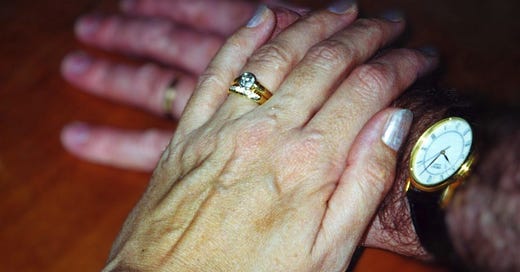Holding On for Dear Life
How grief, music, and movement echo one another in the search for emotional balance
“I know what’s coming, you know? I just. I try not to dwell. Whenever I need it, I put on one of my favourite sad songs and just let myself grieve for 15 straight minutes. Once my alarm beeps, I shake it off, and get on with my life.”
— Paul Rhodes (Harrison Ford as a Senior Therapist in Apple TV’s Shrinking)
Note to new subscribers
If you’ve recently joined for the energy transition posts — welcome, and thank you. This Substack actually began as a space to reflect on quotes from books or shows I’ve been watching. It was mainly for me, but now it seems I have the weight of an audience. These more reflective posts are often paired with a photo from my digital archive (25 years deep, so plenty to choose from) and a music video that catches the mood. It’s a change of pace, but I hope you’ll enjoy it.
Summary
Paul Rhodes uses structured grief as a coping mechanism — a brief, intentional plunge into sorrow, then back to life. Paired with Sia’s Chandelier and its dance interpretation, his method stands in stark contrast to the unfiltered grief expressed through music and movement.
Explanation
Paul Rhodes’ approach to grief is both practical and poetic. He gives himself fifteen minutes — not to avoid grief, but to face it fully, then move forward. It’s an emotional discipline: sad music, a set timer, a ritual of feeling. A personal method born of deep emotional intelligence and, not insignificantly, his career as a psychologist.
Now contrast that with Chandelier by Sia — a song famous for its explosive chorus and barely-contained emotion. The lyric “I'm holding on for dear life, won't look down, won't open my eyes” is a raw confession of someone emotionally suspended, clinging, unwilling to face the pain below.
In the notetoSELF dance performance to Chandelier, we see that line come alive — bodies twisting, collapsing, reaching. It’s grief in motion, the very chaos Paul chooses to contain. The choreography becomes the unscheduled, unbound version of his fifteen-minute ritual. It’s not measured — it’s full surrender.
But both responses are valid. Both are human. One builds a container, the other shatters it. Where Paul chooses stillness, Sia gives us noise; where Paul uses an alarm clock, Sia offers collapse.
And yet both are holding on.
Paul’s grief is particularly moving because it’s directed at something that hasn’t fully happened yet — the loss of his own future. This is anticipatory grief: the quiet sorrow we feel before the goodbye, when we begin to mourn what we know we’ll lose. It’s a form of grief we don’t always name, but many carry — gently, daily — in the background of ordinary life.
Sia – "Chandelier" | notetoSELF Dance
A compelling, emotional choreography that gives physical shape to the lyric “holding on for dear life.” A vivid contrast to Paul Rhodes’ quietly disciplined grief practice.
Watch on YouTube
About Paul Rhodes (and Harrison Ford)
Paul Rhodes is a seasoned therapist facing a terminal diagnosis in Shrinking (Apple TV+), portrayed by Harrison Ford. Paul’s methodical approach to grief — allowing himself 15 minutes of sorrow, then moving on — reflects both his clinical training and a lifetime of guiding others through emotional hardship. Ford brings a quiet warmth and dry humour to Paul, showing us a man who’s holding it together the only way he knows how — not because it’s easy, but because it helps him keep going.
About Sia
Sia is an Australian singer-songwriter known for transforming personal pain into pop anthems. Her breakout hit Chandelier captures the tension between outward bravado and inward collapse — a song about barely holding on, hidden behind a soaring vocal performance. Often writing from the edge of emotional extremes, Sia offers the raw counterpart to Paul’s controlled grief: where he contains, she releases — both honouring sorrow in their own way.
About notetoSELF DanCe Company
notetoSELF is a UK contemporary dance collective made up of grounded, driven, and like-minded artists who collaborate to create emotionally resonant performance work. Based in movement but not defined by it, their choreography centres on the ability to evoke feeling — often exploring themes that live beneath the surface. In their interpretation of Chandelier, they translate emotional chaos into physical form, turning the unspeakable into something seen and felt.




